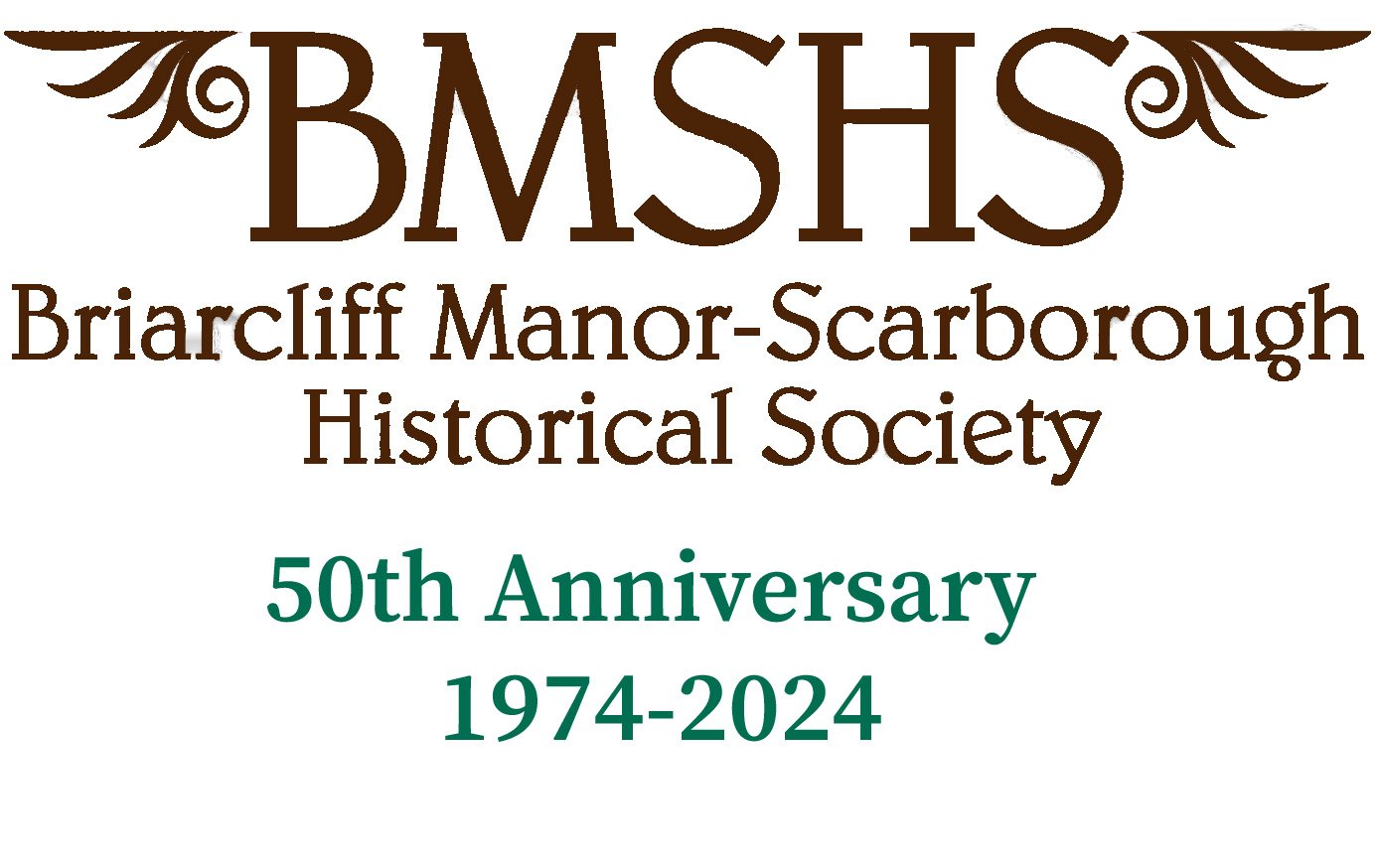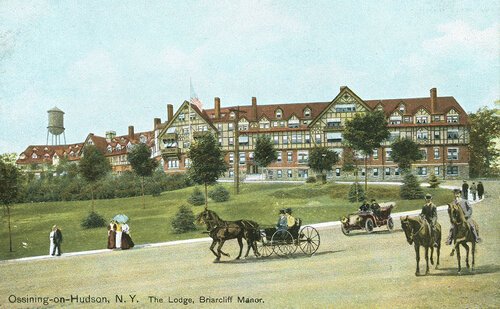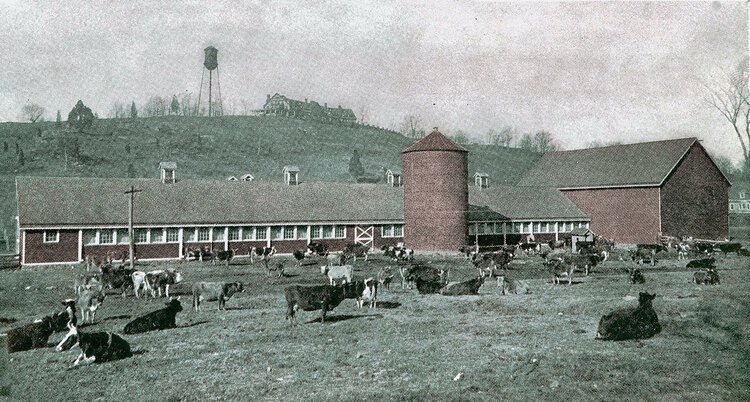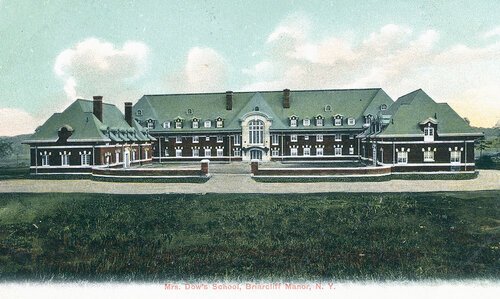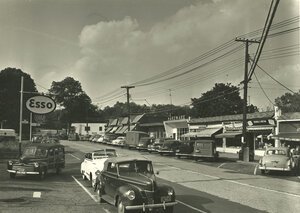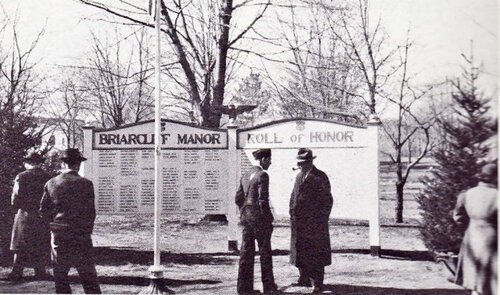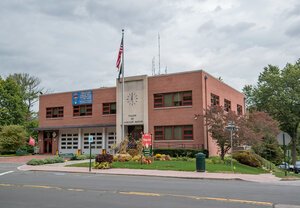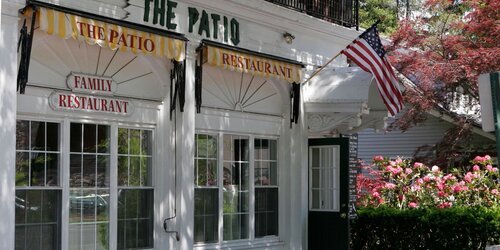A Brief History of Briarcliff Manor - Notebook Vol. 2023-2
The Pre-Colonial Period
The area of Briarcliff Manor-Scarborough was first formed by the retreating glaciers almost twelve thousand years ago. The first inhabitants date from the Archaic period (8000-10000 BC) who lived by the shores of the Hudson river and left behind traces of oyster shells, stone tools and bolas, stones wrapped in hide slings used to hunt birds. By the time Europeans arrived in the mid 15th century, these inhabitants were members of the Sint Sinck (or Sing Sings) tribe who were part of the larger Wappinger Confederacy, a group of tribes united in defense against more warlike peoples of the north. They spoke coastal Munsee, a dialect of the Algonkian language, and called themselves “Lenape” – the People.
In 1685, Frederick Philipse, a Dutch émigré with extensive land holdings in what is now Westchester county and the Bronx, made one of his last land purchases from local members of the Sint Sinck tribe that included the area of Ossining, Scarborough and Briarcliff Manor. Among the chiefs attending the ceremony was Weskora, which subsequently became the name for the area now known as Scarborough. Through much of this period, the land was sparsely populated, as the hilly, rocky landscape did not lend itself easily to farming. During the Revolutionary war, this area was part of “Neutral Ground” between the British camps in New York and the colonial army based further north. Local settlers suffered heavily from raids and pillage of marauders who stole cattle and sold hides to both armies (thus earning the name Cowboys and Skinners). The Philipse family had aligned itself with the English Crown during the war and subsequently lost title to their holdings once peace was concluded in 1783. The territory was sold off in parcels to former tenants.
17th- 19th Century
The area entered the 19th century with increasing numbers of farmers, tradesmen and wealthy families moving north from the city or west from Bedford and Newcastle. Saint Mary’s Episcopal Church was formed in 1839 serving a growing community that included, in part, laborers living in Archville who were working on construction of the Croton Aqueduct. With the opening of the Hudson River railroad in 1849 and increased steamship travel up the Hudson River further change came as the wealthy sought to escape the summer heat and increasingly crowded city conditions to establish vacation homes and gentlemen farms in the region. Inland, the area of Briarcliff Manor became known as Whitson’s Corner, after the family that owned and farmed some 400 acres of land around what is now the junction of Pleasantville Road and South State Road. Here a one room schoolhouse (District no 6) was built in 1865 with land donated by John Whitson. The first post office was established in 1881 and was located in the Joseph Whitson House, called the Crossways. The first train on the New York City and Northern Railroad (later named the Putnam Division of the New York Central) stopped at “Whitson’s Station” in 1880.
By the late 19th century nearly all the land in this area was farmed but this was becoming a less attractive commercial activity as labor migrated towards manufacturing jobs, especially along the Hudson River. Into this environment stepped Walter Law, a vice president of the W&J Sloane Company, who was then living in Yonkers with his wife and five children. At the age of 61, he bought the 236-acre Stillman farm (between Pleasantville and Old Briarcliff roads) in 1890 and subsequently expanded his holdings through further land purchases. In total he completed 40 transactions in less than 10 years that by 1900 included some 5,000 acres. On this property he set about establishing his Briarcliff Farms. At its zenith, Law had 500 workers caring for more than 1,000 cattle, 500 pigs, 4,000 chickens, thoroughbred horses, pheasants, peacocks and sheep. Around the same time, he established the Briarcliff Table Water Company and the Briarcliff Greenhouses. The water company sold its products in five cities and had 250-foot wells. Briarcliff Farms was one of the first producers of certified milk in the U.S., and Law's Jerseys produced about 4,500 US quarts of milk each day. As many as 8,000 roses were shipped from Briarcliff Greenhouses daily, most to New York City.
Walter Law’s Briarcliff
Law was primarily responsible for developing much of what became Briarcliff Manor, including the village, schools, churches, parks and the Briarcliff Lodge. He founded the School of Practical Agriculture in 1900 on Pleasantville Road and had invested extensively in the area by 1902. His employees at Briarcliff Farms moved into the village with Law directly holding some of their mortgages. At the time, New York State required a population density of at least 300 per square mile as the first step towards incorporation as a village. A proposition was presented to the supervisors of Mount Pleasant and Ossining on October 8, 1902 that the area of 640 acres (1 sq mi) with a population of 331 be incorporated as the Village of Briarcliff Manor, and was accepted on November 21. At the time, Law owned all but two small parcels of the square mile village and employed 100 of its residents.
At its 1902 opening, the Briarcliff Lodge was a premier resort hotel. Situated on the highest point of Law’s estate, in Tudor-revival -style. Initially the Lodge served only as a summer residence for New Yorkers but quickly expanded its year-round appeal as a full service lodge through the addition of new rooms, activities and some of the finest chefs in the region. During its time, it hosted numerous distinguished guests, from politicians to movie stars, including Franklin and Eleanor Roosevelt, when he was Governor of New York.
Other notable guests included: John W. Davis, US Representative and nominee for president against Calvin Coolidge, who visited the lodge in 1924. US Senator Chauncey Depew visited in 1924 and 1927. Composer and pianist Percy Grainger gave a recital at the ballroom of the lodge in 1925.
The final German emperor Wilhelm II's son Crown Prince Wilhelm was a guest at the Lodge for the 1909 Hudson-Fulton Celebration. He led a Prussian regiment in a parade of fifty floats held in honor of the celebration in New York.
Other notable guests have included Thomas Edison, Tallulah Bankhead, Sarah Bernhardt, Boris Bakhmeteff, Johnny Weissmuller, Jimmy Walker, Babe Ruth, Edward S. Curtis, George B. Cortelyou, Mary Pickford, F. W. Woolworth, J. P. Morgan, Warner Baxter, Vincent Richards, and Ernestine Schumann-Heink. Elihu Root, Al Smith, and a king of Siam were guests at the lodge in the 1920s, and John Campbell frequently hosted parties there.
Ella Holmes White and her partner Marie Grice Young lived in the Briarcliff Lodge; an extension known as the Oak Room was constructed on the building's east side for them. The two held a long-term lease there before they boarded the RMS Titanic and survived its sinking; they continued to live at the lodge until later in their lives.
In 1903, Mrs. Dow's School for Girls was founded at the Briarcliff Lodge; two years later, Walter Law gave Mary Elizabeth Dow 35 acres and built Dow Hall; the school later became known as Briarcliff College. Also established in 1903, the Briarcliff Manor Fire Department was founded on February 10 by Frederick C. Messinger from Briarcliff Manor's first fire company, the 1901 Briarcliff Steamer Company No. 1. The department's first fire engine was white, which Messinger thought more visible than the conventional red in a village without street lights, and the village's engines remain white today. The first twenty-nine street lights, all electric, were installed in 1904. Law largely developed his land as a business corporation until 1907, when Briarcliff Farms moved to Pine Plains, New York, and Law began promoting Briarcliff Manor as a residential development.
Throughout the early 1900’s the population of Briarcliff grew dramatically and increased further with the annexation of Scarborough in 1910. Through the efforts of the Briarcliff Reality Company, residential building flourished, including several large houses built in the vicinity of the Lodge and owned by former guests. Walter Law died in 1924, but expansion of the community continued, including the creation of the Edith Macy Conference Center in 1925 through a gift of 265 acres by V Everit Macy to the Girl Scouts of the USA. A high school was opened in 1928 and a second road race (following the 1908 event) was sponsored by the Automobile Racing Club of American in 1934, stretching over 100 miles and including many of the roads in Briarcliff.
The 20th Century
Citizens of the community served in both World Wars. Over 91 men from the village enlisted in World War 1 of which two were casualties. The First Provisional Regiment of nearly 1,500 men were garrisoned at the former site of the Holbrook Military Academy and were tasked with guarding the Croton Aqueduct. During World War 2, more than 340 residents, including 14 women joined the military with over half serving overseas during that period. 11 of these were casualties, and today 8 streets within the village are named after those who died in the war.
Briarcliff Manor celebrated its semicentennial in 1952, publishing a book about the village and its history. In 1953, Todd Elementary School opened to free space at the Law Park grade school for middle- and high-school students. The Putnam Division was discontinued in 1958, and the following year the village library reopened in the former train station. The village's first corporate facility (part of Philips Laboratory) opened in 1960. In 1964 the new Village Hall opened, replacing the Municipal Building. The present high school opened in 1971 to ease the large enrollment at the grade-school building. Pace University bought Briarcliff College in 1977 as a satellite of the school's Pleasantville campus. In 1977, the village celebrated its 75th anniversary. Events included a motorcade of fifteen old racing cars participating in a loop around the route of Briarcliff Manor's 1934 road race.
Briarcliff Today
The community continues to evolve with on going changes and development. In 1996, the grade-school building was demolished, and senior housing was built on its site the following year. In November 2001, a major rehabilitation of Law Park was completed, with a new pavilion and pool house, paved walkways, lights and benches, a redesigned and filtered pond, and relocation of the Veterans Memorial. Over 300 people attended the Veterans Day rededication ceremony honoring those who have served including 30 veterans of the Korean War and 5 Vietnam veterans. The village celebrated its centennial in 2002, which involved numerous celebratory events. In summer 2007, construction of a 6,600-square-foot addition to the Briarcliff Manor Public Library began; the facility was opened for use on February 19, 2009.
